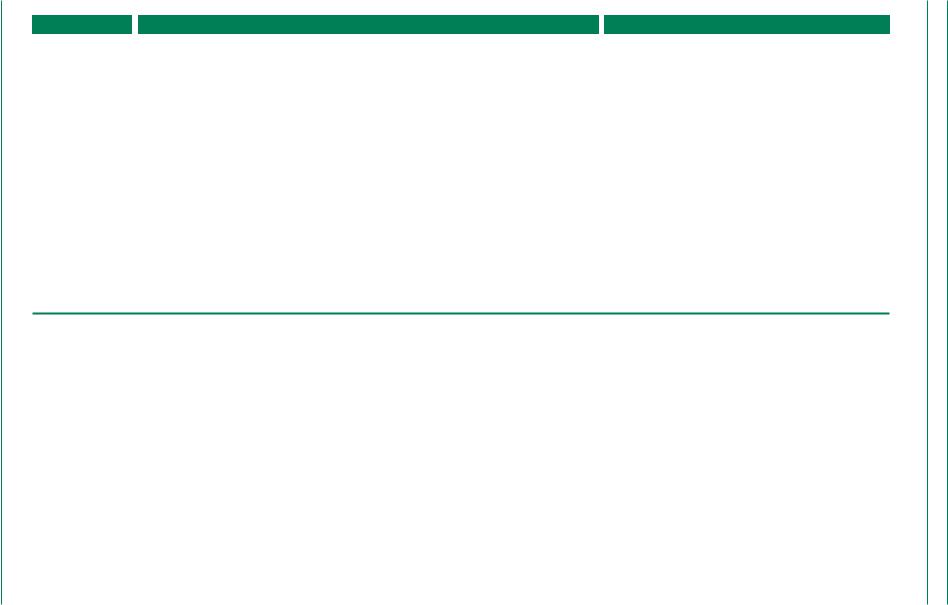Capacity-building in developing countries is key to ensuring their effective engagement in IIAs.
160 |
World Investment Report 2012: Towards a New Generation of Investment Policies |
|
|
flexibilities for contracting parties are not mutually exclusive; rather, the combination of the two helps achieve a balanced agreement that meets the needs of different investment stakeholders. For example, an IIA can combine “strong” substantive protection (e.g. nondiscrimination, capital transfer guarantees) with “strong” exceptions (e.g. national security exceptions or general exceptions to protect essential public policy objectives).29
The policy options presented in the IPFSD IIAelements table are grounded in the Core Principles. For example, (i) the principle of investment protection directly manifests itself in IIA clauses on FET, nondiscrimination, capital transfer, protection in case of expropriation or protection from strife; (ii) the principle of good governance is reflected, amongst others, in IIA clauses that aim at increasing host State’s transparency regarding laws and regulations or in IIA clauses that foster transparency by the foreign investor vis-à-vis the host State; (iii) the right to regulate principle is reflected, amongst others, in IIA clauses stating that investments need to be in accordance with the host country’s laws, allowing countries to lodge reservations (including for future policies); clarifying and circumscribing the content of indirect expropriation or general exceptions.
4.Implementation and institutional mechanisms for policy effectiveness
Implementation of IIAs at the national level entails:
•Completing the ratification process. This may vary from a few months to several years, depending on the countries involved and
the concrete issues at stake. The distinction between the conclusion of an agreement and its entry into force is important, because the legal rights and obligations deriving
from it do not become effective before the treaty has entered into force. The time lag between the conclusion of an IIA and its entry into force may therefore have implications, for both foreign investors and their host countries.
•Bringing national laws and practices into conformity with treaty commitments. As with
any other international treaty, care needs to be taken that the international obligations arising from the IIA are properly translated into national laws and regulations, and depending on the scope of the IIA, e.g. with regard to transparency obligations, also into the administrative practices of the countries involved.
•Disseminating information about IIA obligations. Informing and training ministries,
|
government |
agencies |
and local |
authorities |
|
on |
the implications |
of IIAs for their conduct |
|
in |
regulatory |
and |
administrative |
processes |
|
is important so as to avoid other arms of the |
|
government causing conflicts with treaty |
|
commitments and thus giving rise to investor |
|
grievances, which if unresolved could lead to |
|
arbitral disputes. |
|
|
|
|
|
• |
Preventing |
disputes, |
including |
through |
|
ADR mechanisms. |
|
This |
may |
involve the |
|
establishment |
of |
adequate |
|
institutional |
|
mechanisms to prevent disputes from |
|
emerging and avoid the breach of contracts |
|
and treaties on the part of government |
|
agencies. This involves ensuring that the |
|
State and various government agencies take |
|
account of the legal obligations made under |
|
investment agreements when enacting laws |
|
and implementing policy measures, and |
|
establishing a system to identify more easily |
|
potential areas where disputes with investors |
|
can arise, and to respond to the disputes |
|
where and when they emerge. |
|
|
• |
Managing disputes |
that |
may |
arise under |
IIAs. If dispute prevention efforts fail, States need to be prepared to engage effectively and efficiently in managing the disputes from beginning to end. This involves setting up the required mechanisms to take action in case of the receipt of a notice of arbitration, to handle the case, and ultimately to bring it to a conclusion, including possibly through settlement.
•Establishing a review mechanism to verify periodically the extent to which the IIA contributes to achieving expected results in terms of investment attraction and enhancing sustainable development – while keeping
The IPFSD aims to provide a common language and point of reference for policymakers and investment stakeholders for the participative development of future investment policies.
CHAPTER IV Investment Policy Framework for Sustainable Development |
161 |
|
|
in mind that there is no mono-causal link between concluding an IIA and investment flows.
Moreover, because national and international investment policies must be considered in an integrated manner, and both need to evolve with a country’s changing circumstances, countries have to assess continuously the suitability of their policy choices with regard to key elements of investment protection and promotion, updating model treaties and renegotiating existing IIAs.
Undertaking these implementation and follow-up efforts effectively and efficiently can be burdensome for developing countries, especially the least developed, because they often lack the required institutional capabilities or financial and human resources. Similarly, they often face challenges
when it comes to analyzing ex ante the scope of obligations into which they are entering when they conclude an IIA, and the economic and social implications of the commitments contained in IIAs.
This underlines the importance of capacity-building technical cooperation to help developing countries in assessing various policy options before entering into new agreements and subsequently to assist them in implementing their commitments. IIAs can include relevant provisions to this end, including setting up institutional frameworks under which the contracting parties (and, where appropriate and relevant, other IIA stakeholders such as investors or civil society) can review progress in the implementation of IIA commitments, with a view to maximizing their contribution to sustainable development. International organizations can also play an important capacity-building role.
A new generation of investment policies is emerging, pursuing a broader and more intricate development policy agenda within a framework that seeks to maintain a generally favourable investment climate. “New generation” investment policies recognize that investment is a primary driver
of economic growth and development, and seek to give investment policy a more prominent place in development strategy. They recognize that investment must be responsible, as a prerequisite for inclusive and sustainable development. And in the design of “new generation” investment policies policymakers seek to address longstanding shortcomings of investment policy in a comprehensive manner in order to ensure policy effectiveness and build a stable investment climate.
This chapter has painted the contours of a new investment policy framework for sustainable development. The Core Principles set out the design criteria for investment policies. The national investment policy guidelines suggest how to ensure
integration of investment policy with development strategy, how to ensure policy coherence and design investment policies in support of sustainable development, and how to improve policy effectiveness. The policy options for key elements of IIAs provide guidance to IIA negotiators for the drafting of sustainable-development-friendly agreements; they form the first comprehensive overview of the myriad of options available to them in this respect.
In developing the IPFSD, UNCTAD has had the benefit of a significant body of existing work and experience on the topic. UNCTAD itself has carried out more than 30 investment policy reviews (IPRs) in developing countries over the years (box IV.4), analyzed in detail investment regulations in numerous countries for the purpose of investment facilitation (box IV.6), and produced many publications on best practices in investment policy (box IV.7), including in the WIR series. Other agencies have a similar track record, notably the OECD and the World Bank, various regional organizations, and a number of NGOs. In defining an IPFSD, this chapter has attempted to harness the best of existing work on investment policies, investment policy frameworks,
REFERENCES
Baldwin-Edwards, Martin (2011). “Labour immigration and labour markets in the GCC countries: national patterns and trends”. Research Paper, Kuwait Programme on Development, Governance and Globalisation in the Gulf States, Number 15, March.
British Private Equity and Venture Capital Association (2011). Responsible Investment: A Guide for Private Equity & Venture Capital Firms. London.
China, National Bureau of Statistics (2012). China Statistical Yearbook 2011. Beijing: China Statistical Press.
Deloitte (2011). “Fortresses and footholds: Emerging market growth strategies, practices, and outlook.” Available at: www.deloitte.com.
FAO (Food and Agriculture Organization) (2011). Land Grabbing: Case studies in 17 countries of Latin American and the Caribbean. Available at: www.rlc.fao.org/es/prensa/noticias/estudio-de-la-fao- halla-intensos-procesos-de-concentracion-y-extranjerizacion-de-tierras-en-america-latina-y-el- caribe (accessed 13 June 2012).
ICC (International Chamber of Commerce) (2012). Guidelines for International Investors. Paris: ICC. Available at: www.iccwbo.org/Advocacy-Codes-and-Rules/Document-centre/2012/2012-ICC-Guidelines- for-International-Investment (accessed 13 June 2012).
ILO (International Labour Organization) (2012). Global Employment Trends 2012. Geneva: ILO.
International Energy Agency (2011). World Energy Outlook 2011. Paris: OECD/IEA.
IMF (International Monetary Fund) (2011). “Regional Economic Outlook, Middle East and Central Asia”, October.
Kostyunina, G. (2012), “The impact of Russia’s accession to WTO on FDI”, paper prepared for WIR12.
OECD-UNCTAD (2011). “Report on G20 trade and investment measures” (6th Report October). Available at: http://unctad.org/en/Pages/DIAE/G-20/UNCTAD-OECD-reports.aspx.
OECD-UNCTAD (2012). “Report on G20 trade and investment measures” (7th Report, May). Available at: http://unctad.org/en/Pages/DIAE/G-20/UNCTAD-OECD-reports.aspx.
Peres, Wilson (2011). “Industrial policies in Latin America”. United Nations University, World Institute for Development Economics Research (UNU-WIDER), Working Paper No. 2011/48, September.
PwC (2012). “15th Annual Global CEO Survey 2012.” Available at: www.pwc.com.
Rodríguez, Carlos, Carmen Gómez and Jesús Ferreiro (2009). “A proposal to improve UNCTAD’s FDI potential index”. Transnational Corporations, 18(3): 85–113.
Samba Report Series (2010). “The GCC: increasingly diversified economies”. Available atö www.samba.com.
UNCTAD (2010). “Denunciation of the ICSID Convention and BITs: Impact on Investor-State Claims”. IIA Issues Note, No. 2. Available at: http://unctad.org/en/Docs/webdiaeia20106_en.pdf. (accessed 13 June 2012).
UNCTAD (2011a). “Global investment trends monitor”. No. 5, January.
166 |
World Investment Report 2012: Towards a New Generation of Investment Policies |
|
|
UNCTAD (2011b). Foreign Direct Investment in LDCs: Lessons Learned from the Decade 2001-2010 and the Way Forward. New York and Geneva: United Nations.
UNCTAD (2011c). “Promoting standards for responsible investment in value chains”. Item 1. Report to the High-Level Development Working Group, September. New York and Geneva: United Nations.
UNCTAD (2011d). “Indicators for measuring and maximizing economic value added and job creation arising from private sector investment in value chains”. Item 2. Report to the High-Level Development Working Group, September. New York and Geneva: United Nations.
UNCTAD (2011e). “Options for promoting responsible investment in agriculture”. Report to the High-Level Development Working Group. June. New York and Geneva: United Nations.
UNCTAD (2011f). “Sovereign debt restructuring and international investment agreements”, IIA Issues Note, No. 2. Available at: http://unctad.org/en/Docs/webdiaepcb2011d3_en.pdf. (accessed 13 June 2012).
UNCTAD (2011g). Investment and Enterprise Responsibility Review: Analysis of investor and enterprise policies on corporate social responsibility. New York and Geneva: United Nations.
UNCTAD (2012a). “Latest Developments in Investor-State Dispute Settlement”. IIA Issues Note, No. 1. New York and Geneva: United Nations.
UNCTAD (2012b). “Corporate social responsibility in global value chains: evaluation and monitoring challenges for small and medium sized suppliers in developing countries” (forthcoming).
UN-DESA (2012) World economic situation and prospects 2011: update as of mid-2012. New York: United Nations.
United Nations (2011). Manual on Statistics of International Trade in Services 2010 (MSITS 2010). Geneva, Luxembourg, Madrid, New York, Paris and Washington D.C.: UN, IMF, OECD, EuroStat, UNCTAD, UN-WTO, WTO.
United States Department of Commerce (2011). “Direct investment for 2007–2010 detailed historical-cost positions and related financial and income flows”, Survey of Current Business, September: 50-56.
WIR98. World Investment Report 1998: Trends and Determinants. New York and Geneva: United Nations.
WIR00. World Investment Report 2000: Cross-border Mergers and Acquisitions and Development. New York and Geneva: United Nations.
WIR09. World Investment Report 2009: Transnational Corporations, Agricultural Production and Development. New York and Geneva: United Nations.
WIR10. World Investment Report 2010: Investing in a Low-Carbon Economy. New York and Geneva: United Nations.
WIR11. World Investment Report 2011: Non-equity Modes of International Production and Development. New York and Geneva: United Nations.











